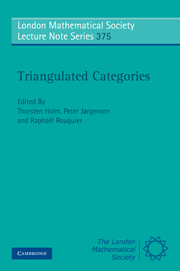Book contents
- Frontmatter
- Contents
- Preface
- Triangulated categories: definitions, properties, and examples
- Cohomology over complete intersections via exterior algebras
- Cluster algebras, quiver representations and triangulated categories
- Localization theory for triangulated categories
- Homological algebra in bivariant K-theory and other triangulated categories. I
- Derived categories and Grothendieck duality
- Derived categories and algebraic geometry
- Triangulated categories for the analysts
- Algebraic versus topological triangulated categories
- Derived categories of coherent sheaves on algebraic varieties
- Rigid dualizing complexes via differential graded algebras (survey)
Localization theory for triangulated categories
Published online by Cambridge University Press: 07 September 2011
- Frontmatter
- Contents
- Preface
- Triangulated categories: definitions, properties, and examples
- Cohomology over complete intersections via exterior algebras
- Cluster algebras, quiver representations and triangulated categories
- Localization theory for triangulated categories
- Homological algebra in bivariant K-theory and other triangulated categories. I
- Derived categories and Grothendieck duality
- Derived categories and algebraic geometry
- Triangulated categories for the analysts
- Algebraic versus topological triangulated categories
- Derived categories of coherent sheaves on algebraic varieties
- Rigid dualizing complexes via differential graded algebras (survey)
Summary
Introduction
These notes provide an introduction to the theory of localization for triangulated categories. Localization is a machinery to formally invert morphisms in a category. We explain this formalism in some detail and we show how it is applied to triangulated categories.
There are basically two ways to approach the localization theory for triangulated categories and both are closely related to each other. To explain this, let us fix a triangulated category T. The first approach is Verdier localization. For this one chooses a full triangulated subcategory S of T and constructs a universal exact functor T → T/S which annihilates the objects belonging to S. In fact, the quotient category T/S is obtained by formally inverting all morphisms σ in T such that the cone of σ belongs to S.
On the other hand, there is Bousfield localization. In this case one considers an exact functor L: T → T together with a natural morphism ηX : X → LX for all X in T such that L(ηX) = η(LX) is invertible. There are two full triangulated subcategories arising from such a localization functor L. We have the subcategory Ker L formed by all L-acyclic objects, and we have the essential image Im L which coincides with the subcategory formed by all L-local objects. Note that L, Ker L, and Im L determine each other.
- Type
- Chapter
- Information
- Triangulated Categories , pp. 161 - 235Publisher: Cambridge University PressPrint publication year: 2010
- 62
- Cited by

